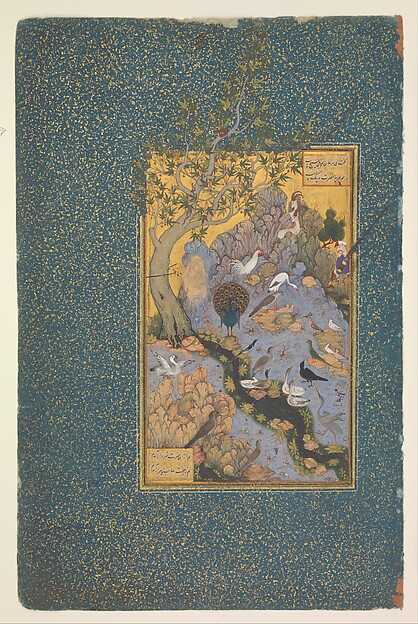
The poetic text of 'Attar’s Mantiq al‑Tair comprises a series of parables narrated by the hoopoe, who leads a gathering of birds on a difficult journey to find the mythic Simurgh. Perhaps the best‑known image from the manuscript, this folio illustrates the small, crested hoopoe bird addressing his companions before their departure. This charming painting is one of four added to the original manuscript in the early seventeenth century at the court of Shah 'Abbas (r. 1587–1629), and is signed by the painter Habiballah.

"The Concourse of the Birds", Folio from a Mantiq al-tair (Language of the Birds)
Painting by Habiballah of Sava (active ca. 1590–1610)

The Concourse of the Birds painted by Habib Allah. The hoopoe, center right, instructs the other birds on the Sufi path.
 Hoopoe
Hoopoe
 Hoopoe
HoopoeIn the poem, the birds of the world gather to decide who is to be their king, as they have none. The hoopoe, the wisest of them all, suggests that they should find the legendary Simorgh, a mythical Persian bird roughly equivalent to the western Phoenix.

The hoopoe leads the birds, each of whom represent a human fault which prevents man from attaining enlightenment. When the group of thirty birds finally reach the dwelling place of the Simorgh, all they find is a lake in which they see their own reflection.
Besides being one of the most celebrated examples of Persian poetry, this book relies on a clever word play between the words Simorgh – a mysterious bird in Iranian mythology which is a symbol often found in sufi literature, and similar to the Phoenix bird – and "si morgh" – meaning "thirty birds" in Persian.
- It was in China, late one moonless night,
- The Simorgh first appeared to mortal sight –
- He let a feather float down through the air,
- And rumours of its fame spread everywhere; [1]
- Come you lost Atoms to your Centre draw,
- And be the Eternal Mirror that you saw:
- Rays that have wander'd into Darkness wide
- Return and back into your Sun subside
One by one, they drop out of the journey, each offering an excuse and unable to endure the journey.
Each bird has a special significance, and a corresponding didactic fault. The guiding bird is the hoopoe, while the nightingale symbolizes the lover. The parrot is seeking the fountain of immortality, not God and the peacock symbolizes the "fallen soul" who is in alliance with Satan.
The birds must cross seven valleys in order to find the Simorgh: Talab (Yearning), Eshq (Love), Marifat (Gnosis), Istighnah (Detachment), Tawheed (Unity of God), Hayrat (Bewilderment) and, finally, Fuqur and Fana (Selflessness and Oblivion in God).
These represent the stations that a Sufi or any individual must pass through to realize the true nature of God.
Within the larger context of the story of the journey of the birds, Attar masterfully tells the reader many didactic short, sweet stories in captivating poetic style.
Eventually only thirty birds remain as they finally arrive in the land of Simorgh – all they see there are each other and the reflection of the thirty birds in a lake – not the mythical Simorgh.
It is the Sufi doctrine that God is not external or separate from the universe, rather is the totality of existence.
The thirty birds seeking the Simorgh realise that Simorgh is nothing more than their transcendent totality.
The idea of God within is an idea intrinsic to most interpretations of Sufism.
As the birds realize the truth, they now reach the station of Baqa (Subsistence) which sits atop the Mountain Qaf.
For more information go to:
http://sufibooks.info/Sufism/The_Conference_of_the_Birds_Fardiuddin_Attar.pdf

This image of this painting by Habib Allah (c.1600) “The Concourse of the Birds” is available from the Wikimedia Commons. The original is in the Metropolitan Museum of Art.
This is an illustration of the Persian mystic, Faridu’ud-Din Attar’s allegory (c.1100?) “The Conference of the Birds” which I believe is also called Mantiqu’t-Tayr Language of the Birds.
This work may have inspired “Journey to the East” by
Herman Hesse.
It describes the seeker’s parallel journey to self-discovery, self-actualization, self-realization through the elusive search for God.
No comments:
Post a Comment